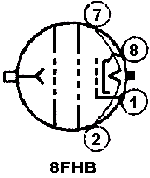Antique radios, Old Time Radios

KRN2
|
Country:
Great Britain (UK)
|
|
Brand:
|
EMI; Hayes, Middlesex |
| Tube type: |
Reflex Klystron |
| |
Ca. 1925 up to 1945 extraordinarily rare.
Production was less than 100 items. **** |
|
| Identical to |
KRN2
= CV87
|
| Similar
Tubes |
Normally replaceable-slightly different:
CV323
|
|
Successor Tubes
|
CV129
|
| Base |
Octal (Int.Octal, IO) K8A, USA 1935
|
| Was used by |
Radar |
| Filament |
Vf 4 Volts / If 1.4 Ampere / Indirect |
| Description |
The first British klystron capable of operating as local oscillator in X-band radar receivers was developed by EMI in close collaboration with the Clarendon Laboratory. The approach was to scale-down the design of the already working S-band ‘Sutton tube’, using the same copper to glass seal technique to connect the external cavity. To prevent unacceptable dielectric losses in the glass wall, the klystron was designed to operate with the harmonic resonator proposed by Blumlein at EMI. The cavity was modified to operate in a three-quarter mode, with nodal circle in correspondence of the glass wall and an antinodal circle between the glass wall and the outer wall of the cavity. KRN2 is the EMI internal code for the device, approved as CV87. A relaxed specs selection, 60 mW output at 3.1 to 3.2 cm, was registered as CV323
The first samples of KRN2 were available for experimentation by March 1941, followed by a production of about 100 units, many of which supplied through 1942 to TRE for their X-band developmental sets.
The tuning system, including a differential screw mechanism, was too complex for volume production. The device was replaced early in 1943 by CV129.
100 mW out with 1500V, 10W. Tuning range 3.05 to 3.45cm.
|
| Information source |
Taschenbuch zum Röhren-Codex 1948/49
-- Original-techn. papers. Callick, Metres to Microwaves
|
|
 KRN2: Manufacturer's Literature
KRN2: Manufacturer's Literature
Emilio Ciardiello
|

Just Qvigstad
|
|
|
|
|
|
You reach this tube or valve page from a search
after clicking the "tubes" tab or by clicking a tube
on a radio model page. You will find thousands
of tubes or valves with interesting links. You
even can look up radio models with a certain tube
line up.
[rmxtube-en]
| Data Compliance |
More Information |
|
|
|



